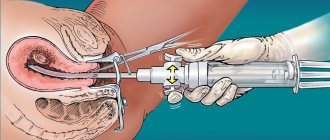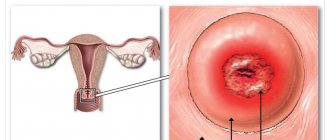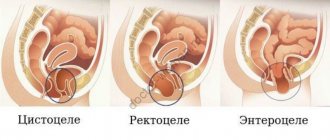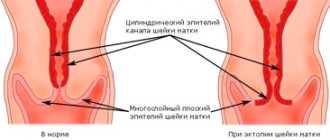Deviation of the uterus from its normal position (retroflexion, bending, bending backward, left or right) is a displacement of this organ in the pelvis. This anatomical position, such as a posterior bend, can be congenital or occurs due to gynecological operations, including surgical abortion, a previous inflammatory process in the appendages and / or insufficiency of ovarian function. Let's talk about this feature of female anatomy, about positions for better conception and useful procedures for the treatment of a posterior bend of the uterus that our clinic offers.
Organ structure
The cervix is the organ that connects the uterus to the vagina. It has a cylindrical shape: in the inner part there is a canal, one end of which is located in the vagina, and the second exits the cavity of the uterine body.
The mucous membrane of the canal is a layer of columnar epithelium. And its vaginal section is lined with stratified squamous epithelium - the same type of tissue that covers the vagina itself.
The transition zone (transformation zone) is the place where the area of columnar cells of the cervical canal passes into the zone of stratified squamous epithelium. It is in the transformation zone that cancer most often develops.
Essential medications and other treatments
First of all, you should find out the reason for this situation and select a combination of therapeutic measures to eliminate it.
Drug therapy may include:
- anti-inflammatory drugs (for inflammation of the ovaries or uterine body);
- antibacterial agents (for infection of the reproductive system);
- absorbable, enzymatic agents;
- hormone therapy;
- vitamin complexes to boost immunity;
- painkillers, antispasmodics;
- gels for intimate hygiene that reduce the risk of developing bacterial microflora in the vagina, for example, the hygienic series of gels from the Ginocomfort brand.
Additionally, a set of special exercises is also prescribed to train the pelvic floor muscles, such as Kegel exercises. It is best to train the muscles in various poses, this way you can achieve greater results and speed up the healing process. The complex also includes physiotherapy. Most often, women suffering from a bent uterus are prescribed:
- UHF;
- mud baths and wraps;
- electrophoresis, which softens adhesions and relieves pain;
- gynecological hardware and manual massage.
Expert opinion
The course of treatment can be up to six months. If you use all available recovery and treatment options, the uterus will eventually return to its normal position and natural conception will become possible.
Obstetrician-gynecologist of the highest category Oksana Anatolyevna Gartleb
If there is no effect from conservative measures, surgical treatment is performed. Endoscopic (laparoscopic) access is considered priority. The operation is performed through two or three small incisions, so it does not require a long recovery period and leaves minimal cosmetic defects. The operation eliminates the consequence of pathological processes, but does not eliminate the cause, which means that over time, the bend of the uterus may reappear. It is important in the postoperative period to treat the factors that caused the disease and prevent relapse.
Neurologist Dmitry Shubin about diseases of the uterus. JitZdorovo
Ectopic cervix
This condition is also called pseudoerosion, endocervicosis. Occurs when columnar epithelium grows in the area of the vaginal part of the canal, the stratified squamous epithelium of which has a pale pink color. The columnar epithelium is red, so on the vaginal surface its area looks like a bright red spot around the external opening of the cervical canal.
Ectopia is usually asymptomatic. In this case, it does not require treatment. More often, natural replacement of ectopic cylindrical cells with flat ones occurs. Modern medicine is increasingly inclined to consider ectopia a variant of the norm.
However, in some cases treatment is required. For example, with a concomitant inflammatory process, bloody discharge from the vagina is observed. Bloody discharge and pain during sexual intercourse are also possible.
The disease is diagnosed using colposcopy.
Reference! Colposcopy is a visual examination of the cervical canal using an optical colposcope.
Treatment is removal of the ectopic area. various methods. Cauterization with electric current, cryodestruction, laser surgery, radiosurgery, pharmacological coagulation.
Ectropion
This disease refers to a complicated form of cervical ectopia. In this case, its mucous membrane turns outward. Cervical ectropion can be either congenital or acquired.
Often the pathology does not manifest itself at all. But sometimes the following symptoms occur:
- failure of the monthly cycle;
- pain in the lumbar region and lower abdomen;
- milky discharge;
- bloody discharge after sexual intercourse.
The concomitant development of other pathologies is possible: leukoplakia, erythroplakia of the cervical canal, and in severe cases, cancer. This means that if ectropion is detected, treatment must be carried out without fail.
Diagnostic measures:
- colposcopy;
- cytological and histological studies;
- blood test for sex hormones;
- hysteroscopy (examination of the uterine cavity).
For ectropion, the following treatment methods are used:
- drug therapy;
- destruction of the pathological zone by various methods;
- conization.
Treatment methods are selected based on the severity of the pathology.
Reference! Conization of the cervix is a minimally invasive surgical operation in which a cone-shaped area of diseased organ tissue is removed.
Factors influencing the development of genital prolapse
- Pathological childbirth (rapid labor, delivery of a large fetus), birth injuries.
- Hard physical labor.
- Estrogen deficiency (early ovarian depletion, menopause, previous surgery to remove the ovaries).
- Somatic pathology, accompanied by increased intra-abdominal pressure (chronic constipation, irritable bowel syndrome, inflammation in the gastrointestinal tract, chronic cough).
- Heredity – the presence of this disease in a grandmother or mother.
- Systemic connective tissue failure (SCT) – genetic congenital connective tissue dysplasia)
Causes of the disease:
- disruptions of the hormonal system
- traumatic lesions of the cervix;
- sexually transmitted diseases;
- human papillomavirus;
- ovarian dysfunction;
- erosion;
- inflammatory processes of the female genital area;
- early sexual life.
The causes, symptoms and form of the disease are related.
Leukoplakia of the cervix can manifest itself in 3 forms:
- Simple - located in the same plane with the walls of the mucous membrane. It is often asymptomatic. As the disease progresses, itching in the perineal area, vaginal dryness, and discomfort during sex occur.
- Proliferative or warty - rises above the walls of the organ. Unpleasant sensations and burning sensation in the perineum. Wart-like formations can spread to the external genitalia.
- Erosive - manifests itself in the form of depressions in the upper layer of the epithelium. After sexual intercourse, a woman experiences bleeding.
With leukoplakia, malignancy is possible, so it requires mandatory treatment.
Diagnostics includes the following methods:
- colposcopy;
- cytological and histological studies;
- flora smear;
- blood tests for STDs, HPV;
- immunogram;
- blood test for sex hormones.
Treatment is aimed at removing the affected areas. And, depending on the cause of the disease - to destroy the infection, correct the immune and hormonal status of the patient.
Leading specialists in the treatment of vaginal wall prolapse in the North Caucasus
Ermolaeva Elvira Kadirovna A well-known and recognized specialist in the North Caucasus in the treatment of prolapse of the walls of the vagina and uterus WITHOUT SURGERY, reduction of the vagina with vaginal threads and treatment of urinary incontinence. Women who are exhausted by vaginal prolapse and who want to improve the aesthetics of the genital organs and refresh intimate relationships come to her from women from all regions of Russia and foreign countries.
Ermolaev Oleg Yurievich Candidate of Medical Sciences, operating gynecologist with 25 years of successful experience in treating uterine prolapse and prolapse of the vaginal walls, uterine prolapse in old age. Able to see relationships that elude others.
About the doctors of the Clinic in detail...
| The company "Resort Clinic for Women's Health" LLC was among the NOMINANTS and has the right to receive the STATUS "Best Enterprise in Russia 2019". The analysis was carried out based on data from the State Statistics Service, according to OKVED 86.21 “General Medical Practice”. According to the indicators of the last reporting period, Women's Health Resort Clinic LLC was classified as a reliable enterprise and, based on the rating, took “1” (first) place among all companies in the region (North Caucasus Federal District). |
We accept girls and women from all cities of Russia, near and far abroad, and assist in accommodation. About accommodation in detail...
The resort clinic for women's health operates on a paid basis and in the voluntary health insurance system.
We work WITHOUT WEEKENDS and holidays:
Monday - Friday from 8.00 to 20.00, Saturday, Sunday, holidays from 8.00 to 17.00.
Treatment of prolapse of the posterior vaginal wall in Pyatigorsk by appointment by multi-channel telephone (calls within Russia are free), or +7 (928) 022-05-32.
WE HELP even in the MOST difficult cases.
| ONLINE information about the treatment of prolapse of the posterior vaginal wall can be found here. REGISTER ONLINE for treatment of prolapse of the posterior vaginal wall here. REGISTER online for treatment of prolapse of the posterior vaginal wall according to |
Sign up
With respect for the religion and different habits of our Patients, we achieve high efficiency and comfort of treatment.
We are at your FULL DISPOSAL if you have any doubts or wishes.
- About the Clinic
- Clinic team
- Vaginal prolapse REVIEWS
- REDUCTION OF THE VAGINA WITH VAGINAL THREADS
- How to prepare for an appointment with a gynecologist?
Erythroplakia of the cervix
These are atrophic changes in the mucous tissue that occur due to the thinning of the stratified squamous epithelium.
The cause of the pathology is not reliably known.
Often the disease is asymptomatic. Erythroplakia of the cervix is often accompanied by inflammatory diseases - colpitis and cervicitis. In this case, milky discharge and bloody discharge after sexual intercourse are possible.
If erythroplakia is accompanied by atypical hyperplasia, this refers to precancerous conditions.
Diagnostics:
- colposcopy;
- flora smear;
- cytological and histological analyzes of the material.
Treatment is aimed at eliminating inflammatory processes. If atypical cells are detected, the affected area is subject to destruction.
Cervical polyps
These are benign neoplasms on the surface of the mucous membrane of an organ. During a gynecological examination, polyps appear as red or purple growths.
Typically, polyposis occurs without significant symptoms. However, it can cause leucorrhoea, excessively heavy periods, vaginal bleeding during the postmenopausal period, and contact bleeding.
The etiology of the disease has not been reliably clarified.
The diagnosis of cervical polyp is confirmed by histological analysis of biomaterial, which is taken during the examination.
Polyps rarely degenerate into a malignant tumor - no more than 1% of cases.
Treatment of the disease consists of two stages - surgical removal of the polyp and a rehabilitation period.
The advantages of my original method of treating genital prolapse:
- preservation of the most natural anatomical and topographic relationships of the pelvic organs;
- minimizing the risk of recurrence of uterine prolapse;
- minimal risk of postoperative complications (erosions of the vaginal mucosa, dyspareunia, damage to neighboring organs, bleeding, infectious complications) - up to 0.1% compared to 30% when using Prolift);
- minimal trauma
- improving the quality of life (the possibility of sexual activity is not limited, unlike the Prolift operation);
- the fastest possible rehabilitation period (the average length of hospitalization after surgery does not exceed 3 days, the possibility of vigorous activity remains);
- no need for long-term hormonal preparation before surgery (unlike classical promontofixation and installation of the Prolift system);
- the possibility of simultaneous correction of other extragenital and gynecological pathologies (pelvic diseases - fibroids, adenomyosis, tubal adhesions, ovarian cysts, etc., each of which seriously affects a woman’s health and ability to bear children).
Diploma
For the best work in the section “Laporoscopic methods in coloproctology”
Formula of invention to the RF patent
Patent holder(s): Konstantin Viktorovich Puchkov
The results of treatment of patients with pelvic prolapse are summarized in three monographs “Laparoscopic operations in gynecology”, “Simultaneous laparoscopic surgical interventions in surgery and gynecology” and “Minimally invasive colon surgery”, as well as in more than 20 scientific publications in various professional peer-reviewed scientific publications in Russia and abroad. As a result of many years of positive attempts to use this technique, we received patent No. 2015126579 of the Russian Federation “Method of laparoscopic promontofixation / K.V. Puchkov, V.V. Korennaya, D.K. Puchkov.- No. 2 2015126579/14; appl. 07/02/2015; publ. 03/09/2017, Bulletin 7.
Dysplasia
Atypical changes in the structure of the squamous epithelium are called cervical dysplasia. This condition is classified as precancerous.
Dysplasia has 3 degrees of severity:
I degree – slight atypia of epithelial cells is detected. The pathological layer extends to less than 1/3 of the thickness of the walls of the cervix.
I degree – average degree of cell change. The atypical layer occupies half or more of the thickness of the organ walls.
III degree – significant cellular pathology, which is widespread? channel thickness.
Dysplasia progresses relatively slowly and is capable of complete recovery with timely diagnosis.
At the first stage, the gynecologist can take a wait-and-see approach with periodic monitoring of the disease - often the woman’s body copes with mild atypia on its own.
At the second stage, destruction of the affected area is prescribed using various methods.
In the third stage, conization of the cervix is usually performed.
Dysplasia is usually asymptomatic and can only be detected through a specific test - a cytological smear (PAP smear). Then colposcopy and mandatory histological examination of a sample of the affected tissue are performed.







